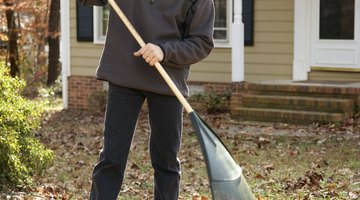Laying Concrete Over Sprinkler Lines
To lay concrete over sprinkler lines, the pipes need to be recessed into trenches in the ground. Decommission the sprinkler system by removing the heads and sealing the inlet valve if the system is no longer in use. If it is still active, however, you need to ensure that your lines are leak-free before covering them with concrete. For cold climates, burying the lines below the soil frost line will provide more protection against freezing.

Things You Will Need
- Trenching machine
- Narrow-blade trenching shovel
- Pressure roller
- Wooden frame
- Gravel
- Premixed concrete
- Curing compound
-
Check the sprinkler lines that you plan to cover with concrete. Test them for leaks and check all joints and washers. Repair or replace any problem sections to ensure that they are solid before covering.
-
Water the soil thoroughly to soften it before digging the trenches. Use a trenching machine to dig the trenches, which should be approximately 10 inches deep to accommodate the lines or pipes. The standard depth for commercial installations is 12 inches deep, but a depth of 10 inches is acceptable for home irrigation systems.
-
Remove the loose dirt from the bottom of the trenches using a narrow-blade trenching shovel. The base of the trench should be smooth and free of stones and debris. Position the sprinkler lines in the trenches and cover them with loose soil.
-
Fill the trenches and compact the soil as much as possible without risking damage to the lines. Leave the trenches for a day or two to allow the dirt to settle.
-
Prepare the area where you plan to lay concrete by removing any rocks and debris. Rake it smooth and compact it using a pressure roller.
-
Position a wooden frame around the area you intend to cover with concrete. Spread a layer of gravel over the entire area, approximately 2 inches deep.
-
Pour the premixed concrete over the gravel and allow it to harden for 24 hours. Spray the concrete with curing compound once it is dry.
Tip
Mark the edge of the concrete on all sides where the sprinkler lines enter underneath it. This will give you an approximate idea of their location, in case one of the pipes develops a leak and may help you avoid digging up the entire concrete area to repair it.
References
Writer Bio
Tracey Sandilands has written professionally since 1990, covering business, home ownership and pets. She holds a professional business management qualification, a bachelor's degree in communications and a diploma in public relations and journalism. Sandilands is the former editor of an international property news portal and an experienced dog breeder and trainer.
Photo Credits
- Creatas Images/Creatas/Getty Images
- Creatas Images/Creatas/Getty Images
More Articles



